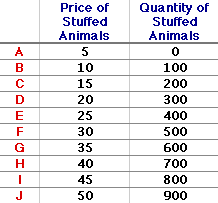At higher prices, a larger quantity will generally be supplied than at lower prices, ceteris paribus (all other thing being constant). So at a lower price a smaller quantity is produced.
This simply describes the upward sloping supply curve. The curve denotes that there is a ‘positive’ or ‘direct’ relationship between price and quantity. As one factor increases so does the other.
But why does this happen?
Suppliers have the incentive of profits, if a crop is doing well they will try and shift supply up so that they can make more profits.
The law of increasing opportunity costs means that as you increases supply of one good you must sacrifice greater and greater amounts of other resources. Therefore, as output increases , costs of producing goods increases thus the supplier must charge higher prices.
The supply curve
A supply schedule is simply a table of data showing the quantity that suppliers plan to supply at each level e.g.

A supply curve is a line which shows the quantity that suppliers plan to supply at each level e.g.:

Notice that as price increases the level of supply increases. (Positive correlation)
Shifts
The supply can shift left of right if there is a change in the quantity that supplier would supply at every price.

For example in this diagram we can see that the supply shifts to the right which is an increase in supply.
At price of P1, we can see supply increase (Sorry not that clear on this particular diagram) Notice a shift in the opposite direction from S1 to S0 would be a decrease in supply.
What causes these shifts to occur?
A shift in supply is caused by non-price determinants. There are 5 main ones you need to know:
1. Changes in costs of production: The lower the costs the greater the profit for producers. Examples of this are; input prices (raw material, rent etc.) , changes in technology (e.g. internet) , organisational changes , subsidies and taxes.
2. Profitability of alternatives; if another good becomes more profitable then a firm will switch t produce more of that e.g. the transition between cd players to MP3 players.
3. Profitability of goods in joint supply; If the supply of one good e.g. cattle increases then so will the joint good e.g.leather
4. Random shocks e.g. strikes, weather, wars, earthquakes etc.
5. Expectations of future price changes; for example if a firm expects price to rise they will either produce more or hold onto stock.
IMPORTANT:
NON-PRICE DETERMINANTS CAUSES SHIFTS AND PRICE DETERMINANTS CAUSES MOVEMENTS ALONG SUPPLY CURVE.
Need more help...check my video out!
No comments:
Post a Comment